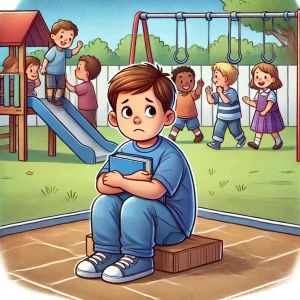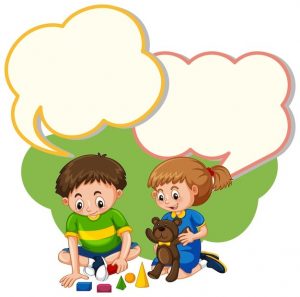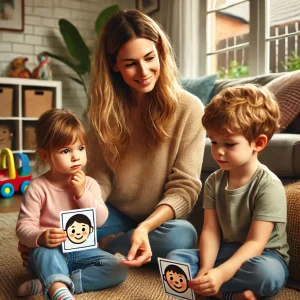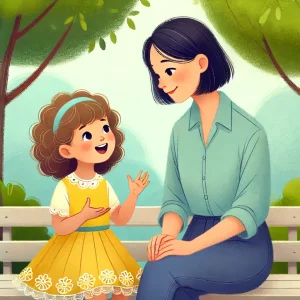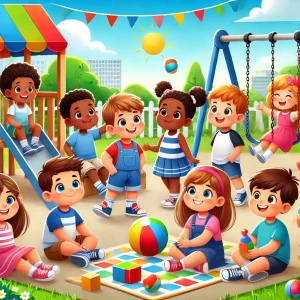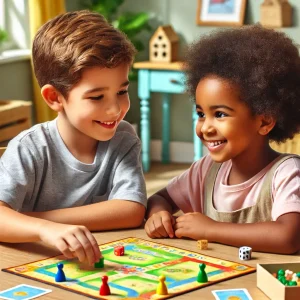6 Key Practices for Mastering Social Stories for Autism
Last Updated: January 20, 2025
Welcome to the world of social stories, a vital tool in autism therapy. These short narratives are designed to help children with autism understand social cues, others’ perspectives, and appropriate social responses. Originally developed by Carol Gray in 1991, social stories break down complex interactions into manageable parts, empowering children to navigate social situations more confidently. In this article, we’ll uncover six key practices to create effective social stories that resonate with and support your child’s learning. Join us as we delve into these transformative techniques.
Help your child navigate social situations with ease – Download our expertly designed social stories tailored for kids with autism and ADHD.
Understanding the Basics of Social Stories
Social stories are short guides that help children with autism understand how to act in social situations. Created by Carol Gray in 1991, these stories teach appropriate social behaviors through simple, clear examples. Each story describes a situation, shows what others might expect, and explains what the child could do.
These stories help children predict what might happen in social interactions, like sharing or taking turns, making it easier for them to know how to respond. By using social stories regularly, children can learn to navigate social challenges more confidently and effectively, making everyday social exchanges smoother and more enjoyable.
Key Practice 1: Personalization
Importance of Personalization
- Tailoring social stories to a child’s own experiences and interests makes the stories more relatable and effective.
- Personalization helps children see themselves in the stories, which boosts understanding and engagement.
Examples of Personalization
- If a child loves trains, include train-themed scenarios to teach about waiting turns or sharing.
- Use familiar settings, like the child’s home or school, to make social rules clearer and more direct.
Key Practice 2: Simplicity and Clarity
Importance of Clear Language
- Simple language ensures that children with autism can easily grasp the social lessons in the stories.
- Clear, direct sentences help prevent misunderstandings and confusion.
Tips for Language and Structure
- Use short, concise sentences to maintain clarity.
- Choose words that the child already knows and understands.
- Structure stories with a clear beginning, middle, and end to establish a predictable pattern.
Key Practice 3: Visual Support
Role of Visuals
- Visuals can make abstract social concepts concrete and easier to understand for children with autism.
- Pictures, symbols, and photographs help clarify the text and keep the child engaged.
Integrating Visuals Effectively
- Use consistent and recognizable images that relate directly to the story’s content.
- Include visuals that match the text exactly to reinforce the message.
- Place visuals close to the corresponding text to help children make connections between words and images.
Key Practice 4: Consistency
Importance of Regularity and Repetition
- Regular use of social stories helps children with autism internalize and apply the lessons consistently.
- Repetition reinforces understanding and makes behaviors more predictable and manageable.
Strategies for Daily Integration
- Incorporate social stories into daily routines, such as during breakfast or bedtime.
- Use social stories before specific events, like going to the park or a doctor’s visit, to prepare the child.
Key Practice 5: Engagement
Making Social Stories Interactive
- Turn social story reading into a two-way activity by asking the child questions about the story.
- Encourage the child to guess what might happen next or to suggest different endings.
Techniques for Reinforcement
- Use prompts and role-playing based on the social story to practice behaviors in a safe, controlled environment.
- Create interactive elements like fill-in-the-blanks or matching pictures to words to make learning active and fun.
Key Practice 6: Feedback and Adaptation
Gathering Feedback
- Regularly ask the child and other caregivers about their thoughts on the stories and any observed effects.
- Take note of the child’s reactions and questions to gauge comprehension and interest.
Adapting the Stories
- Modify stories based on feedback to better suit the child’s evolving needs and interests.
- Update scenarios and settings in the stories to match the child’s developmental changes and current learning focus.
Our social stories help children with autism and ADHD understand routines, emotions, and interactions. Make learning fun and simple – Download Now
Benefits of Each Practice in Social Stories
| Practice | Benefits |
|---|---|
| Personalization | Increases relevance and engagement, helping the child to better connect with the story’s content. |
| Simplicity and Clarity | Enhances understanding, ensuring the child can easily grasp and remember the lessons taught. |
| Visual Support | Aids comprehension for visual learners and reinforces the verbal message through imagery. |
| Consistency | Helps solidify behaviors and routines, making the child more comfortable with social expectations. |
| Engagement | Encourages active participation, which can improve learning outcomes and retention of information. |
| Feedback and Adaptation | Keeps the material relevant as the child’s needs evolve, ensuring ongoing effectiveness of the stories. |
Conclusion
We’ve covered six key practices to make social stories work better for kids with autism: making them personal, keeping them simple, using clear pictures, staying consistent, making them interactive, and adjusting based on feedback. These tips help kids understand and enjoy social interactions more.
Try these strategies and see what fits best for your child. Adjust the stories as needed—your efforts can really boost their confidence and skills in social settings. For more tips and resources, check out our Wellness Hub on effective autism therapies. Let’s make learning fun and effective together!
Frequently Asked Questions:
1. What are social stories for autism?
Social stories are customized, short descriptions designed specifically to teach children with autism acceptable social behavior through example-based scenarios. They illustrate a range of social situations, explaining the cues and appropriate responses to help children navigate interactions more effectively.
2. How do social stories help children with autism?
Social stories aid children by breaking down complex social cues into manageable, relatable pieces. By clearly outlining what others might expect in various situations and suggesting appropriate behaviors, these stories help children with autism anticipate and engage in social interactions with less anxiety.
3. Can I make my own social stories for my child?
Absolutely! Creating personalized social stories that reflect your child’s interests and daily experiences can enhance their relevance and effectiveness. This personal touch makes it easier for your child to connect with the story and apply its lessons in real life.
4. What should I include in a social story for autism?
A social story should include simple, direct language and supportive visuals like pictures or symbols. Detail everyday scenarios your child might encounter, clearly outlining expected behaviors and why these behaviors are important in social contexts.
5. How often should I use social stories with my child?
Regular use is key. Integrate social stories into your daily routine to reinforce learning. Additionally, presenting these stories before upcoming events or new experiences can prepare your child for what to expect and how to behave.
6. What makes a social story effective for autism?
An effective social story resonates with the child’s experiences, uses clear and concise language, maintains a consistent structure, and includes interactive elements like role-playing or questions to engage the child actively in the learning process.
7. How can I tell if the social story is working?
Observe your child’s behavior in social settings. Improvements in understanding social cues and engaging appropriately with others are good indicators that the social stories are having a positive impact.
8. Can social stories be used for all children with autism?
Yes, social stories are versatile tools that can be tailored to suit children at different developmental stages and with varying needs. They can be adapted in complexity and content to grow with your child.
9. Where can I find examples of social stories for autism?
For templates and example stories, visit the Wellness Hub’s therapy tools page. This resource offers a variety of stories that you can use as a starting point to customize further based on your child’s specific needs.
10. How do I adapt a social story as my child grows?
Update the content of social stories to reflect your child’s growing abilities and changing social environments. Regular feedback from your child and observations of their interactions can guide you in making these stories more relevant and engaging as they develop.
About the Author:
Shravanaveena Gajula
M.Sc ., Speech and Language Pathology (5+ years of experience)
Shravanaveena Gajula is a dedicated Audiologist and Speech-Language Pathologist with a BASLP and an M.Sc in Speech and Language Pathology. With experience spanning multiple settings, including Wellness Hub and Ashray Akruti, Veena specializes in a wide range of disorders from developmental issues in children to speech and language assessments in adults. Her expertise includes parent counseling, managing speech sound and fluency disorders, and creating individualized therapy programs. Veena is also PROMPT certified and an author of several insightful blogs on speech and language pathology, aiming to educate and assist caregivers in supporting their loved ones.
Book your Free Consultation Today
Parent/Caregiver Info:
Client’s Details:
* Error Message
